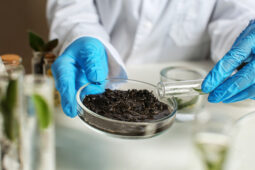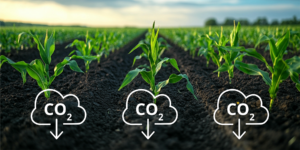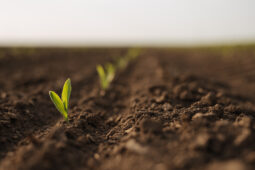There is increasing dialogue and excitement about microbial biostimulants due to their potential as environmentally sustainable resources for agricultural production. Often positioned as tools for growers seeking to mitigate fertilizer shortages, increasing input costs, and as a means by which to overcome the impact of yield-limiting factors or challenging growing conditions, the terms “microbials” and “biostimulants” are frequently used interchangeably. However, this isn’t entirely accurate and misrepresents the products and challenges for which they are designed to address.
Not all microbials are biostimulants, and likewise, not all biostimulants are microbial in nature. If we are to understand the power of microbial biostimulants and how they can be harnessed in agriculture, we must first look at each of the terms individually for a proper understanding of what they are and how they work.
What are Microbes and What do They do?
Microbes, or microorganisms, are tiny living things that are found all around us and are too small to be seen by the naked eye. They live in water, soil, air, and on and within the bodies of plants and animals – including humans. No living thing is an island: all of us, and indeed every form of multicellular life studied to date, host a microbiome full of microbes that support their host’s health and proper functioning.
The diversity of microbes encompasses a wide range of actors. An infamous minority of microbes, called pathogens, cause disease in humans and the animals and plants that we cultivate. Although these microorganisms often dominate headlines, viewing all microscopic life through the lens of these undesirables paints a distorted picture of the microbial world and its relationship with our own.
Many microbes, often obscure, carry out biochemical processes which benefit agriculture. Some of these beneficial microbes secrete compounds that liberate bound nutrients in the soil – nutrients such as phosphorous, zinc, and potassium – and make them available to plants. Others have learned to capture nitrogen gas from the atmosphere and convert it into compounds that can be taken up by plants. Certain species compete with pathogens for space and resources, and the resulting biological “arms race” has equipped some microbes with chemical armaments to fight off pathogenic fungi as well as larger foes such as nematodes and insect pests. It is no surprise that, having identified all these useful roles for microorganisms, humans have found ways to harness their abilities and deploy them in bioherbicides, biopesticides, biofertilizers, and biostimulants. Let’s take a closer look at the latter.
What are Plant Biostimulants and What do They do?
The definition of “biostimulant” advanced by American Association of Plant Food Control Officials (AAPFCO) in February 2022 and adopted in the Plant Biostimulant Act recently proposed in Congress with bipartisan support, states the following:
“Plant biostimulant” means a product stimulating plant nutrition processes independently of the product’s nutrient content with the sole aim of improving one or more of the following characteristics of the plant or the plant rhizosphere: (a) nutritional use efficiency; (b) tolerance to abiotic stress; (c) quality traits; or (d) availability of confined nutrients in the soil or rhizosphere.”
While not specifically defining “microbial biostimulants,” some microbials can be considered plant biostimulants under this definition, based on functionality. Other plant biostimulants, such as humic substances or seaweed extracts, are not microbes. Humic substances are mixtures of nonliving chemical compounds such as humic acids, humates, and fulvic acids, and seaweed extracts, while derived from living things, are mixtures of specific biomolecules that do not contain any living cells.
This brings us to….What are Microbial Plant Biostimulants and What do They do?
Microbial biostimulants are products formulated with living microorganisms that are intended to fulfill one or more of the roles described in the AAPFCO plant biostimulants definition above: “(a) nutritional use efficiency; (b) tolerance to abiotic stress; (c) quality traits; or (d) availability of confined nutrients in the soil or rhizosphere.”
More specifically, BiOWiSH® Crop Liquid product enhances beneficial microbes in the rhizosphere. Featuring our proprietary HoloGene 3™ Technology, BiOWiSH® endophytic Bacillus deliver soil nutrients to crops through the rhizophagy cycle, creating a symbiotic relationship between the plant and soil microbes. This improves soil conditions for increased plant vigor, optimizes soil conditions for greater root mass, increases nutrient use efficiency and supports nutrient uptake. All this ultimately optimizes yield potential by improved nutrient uptake.
To take this a step further, the unique formulation can be coated directly onto dry fertilizer or mixed with liquid fertilizer to create a Bio-Enhanced Fertilizer – representing a new class of Enhanced Efficiency Fertilizer (EEF).
Unlike other EEF technologies, the benefits of BiOWiSH® Enhanced Fertilizer don’t stop with improving the nutrient conditions of the soil for better overall plant mass. As the BiOWiSH® Enhanced Fertilizer relies upon both direct and indirect microbial nutrient uptake enhancements, nutrient availability is improved via multiple modes of action simultaneously. Being that there is currently no classification of EEF that includes microbial products with these modes of action, BiOWiSH® Enhanced Fertilizer is in a new class, a class of its own.
To conclude, organisms contained in microbial biostimulants can fill many roles and represent an exciting, sustainable option for growers looking to leverage the power of biology to protect and enhance their bottom line. For more information on how to select an agronomic microbial that’s right for your farm, check our 3-part blog: Not All Agronomic Microbial Solutions are Created Equally.
Author
John Gorsuch
Director of R&D
BiOWiSH Technologies Inc.
Cincinnati, Ohio 45208 USA





